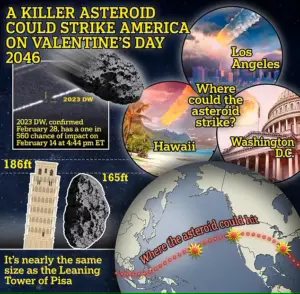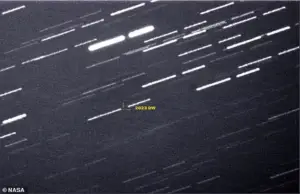NASA has warned of a city-destroying asteroid hitting Earth on Valentine’s Day in 2046.
2023 DW, confirmed February 28, has a one in 560 probability of impact on February 14 at 4:44 pm ET. Its place of impact is unknown.
Los Angeles, Hawaii, and Washington DC are potential impact sites.
The 165-foot 2023 DW would hit Earth like the 12-megaton Tunguska explosion 114 years ago.
This 160-foot asteroid flattened 80 million trees in a forest after causing a nuclear explosion that would have devastated a big urban region.
NASA announced the discovery of 2023 DW on Tuesday, noting that it ‘takes several weeks of data to reduce the uncertainties and adequately predict their orbits years into the future.’
Last week, the asteroid’s chance of impacting Earth changed.
On March 1, an Italian astronomer shared NASA’s one in 1,2000 possibility. A day later, it was one in 710, and now it’s one in 560.
62 observations over 6.8487 days were used to analyze its orbit as of March 7, 2023.
2023 DW tops NASA’s Hazard List with a 1 on the Torino scale, indicating little public concern.
‘A routine discovery in which a pass near the Earth is predicted that poses no unusual level of danger,’ reads the description on the Torino scale.
NASA tweeted, ‘Orbit analysts will watch asteroid 2023 DW and revise forecasts as additional data comes in.
2023 DW might reach 10, dubbed “Certain Collisions,” from 1.
‘A collision is certain, capable of causing global climatic catastrophe that may threaten the future of civilization as we know it, whether impacting land or ocean,’ reads the description.
‘Such events occur on average once per 100,000 years, or less often.’
NASA will notify the public if 2023 DW hits 3.
Chelyabinsk, February 15, 2013, was the last major impact.
A 60-foot-wide meteor impacted Earth’s atmosphere with the intensity of 500,000 tons of TNT, sending a shockwave twice around the world.
Almost 1,600 people were hurt.
2023 DW is larger.
With its 2021 DART mission, NASA proved it can deflect a lethal asteroid.
NASA’s first planetary defense mission, DART, was launched in 2022 for humanity’s “Armageddon moment.”
The ship targeted Dimorphos, a moonlet orbiting Didymos, its parent asteroid.
DART flew 15,000 mph at Dimorphos on September 26 to knock it off orbit.
NASA announced their success on March 1, 2023.
The space agency’s refrigerator-sized satellite cut 33 minutes off a 520-foot-wide asteroid’s orbit, roughly five times more than projected.
Scientists from the Northern Arizona University said: ‘This serves as a proof-of-concept for the kinetic impactor technique of planetary defense, DART needed to demonstrate that an asteroid could be targeted during a high-speed encounter and that the target’s orbit could be changed.’
Reference(s):



